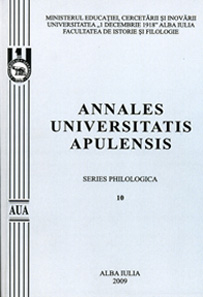LA SAISIE INTERDISCIPLINAIRE DE L’ESPACE ET DU TEMPS. GÉOGRAPHIE ET LITTÉRATURE. PARIS CHEZ ITALO CALVINO, GEORGES PEREC
INTERDISCIPLINARY SEIZURE OF SPACE AND TIME. GEOGRAPHY AND LITERATURE. PARIS IN ITALO CALVINO, GEORGES PEREC’S VISION
Author(s): Corina MoldovanSubject(s): Literary Texts
Published by: Universitatea »1 Decembrie 1918« Alba Iulia
Keywords: geography; literature; geocriticism; referent; representation; town; intertextuality
Summary/Abstract: At the beginning of the 21st century, the indestructible relation between time and space coordinates is obvious. Bakchtine’s chronotope from The Dialogic Imagination understood as a structure element for the genres has had an immense impact on the future studies, non only in the field of literary theory but also in other fields such as architecture, urbanism, or history. In a 1991 essay, Tempo e progetto. L’architettura come narrazione, Elena Calvi defines the vital space as “a product of the articulation, interconexion and mutual relativization of time and space”. In the same period as the Bakhtin studies, Fernand Braudel, in The Ambitions of the history, completes the chronotope theory with the geohistory one, as the study of “a double relation, between nature with man and man with nature, the study of an action and reaction, mixed up, merged, restarted permanently, in each day’s reality”. Both the chronotope theory ans the geohistory contributed to the rise of the studies in the cultural geography studies, from the tidsgeografi of Torten Hagerstrand to the reflections on the postmodern condition as expressed by David Harley (The Postmodern Condition, 1990). The two disciplines, geography and literature fusion in the new, modern method known as the “geocriticism”, based on the identification of the non formal and non determinist valence of geography, defined today as an “sphere of ideas”, whilst the literature “fills” the geographic imaginary, and recreates it. Therefore, as Andrew Stasiuk said, “the geographical field and the imagination are only apparently different, in fact they are as closely connected as the madness and sanity. And this is as for building a world, which is the greatest and the noblest human aspiration means to invest that world’s space”. In the two literary analyses proposed we handle two different manners of investing the space. Italo Calvino’s Paris, in Eremita a Parigi, is a “huge inventory, a huge a book of dreams, an album of our collective unconsciousness”. For Georges Perec, in Tentative d’epuisement d’un lieu parisien, the town becomes text during forty-eight hours’ time as observed and noted by the author in the same Saint-Sulpice Place. If in the first case we deal with the impossibility of expressing the intimate vision of the town because of the excess of referentiality, in the second one the real town suffocates and eventually kills the text, as the author is forced to abandon it. The interdisciplinary method proposed by the geocriticism starts from these multiple perspectives and creates a complex questioning. Geocriticism defines itself as a interdisciplinary reading, an interface between different disciplines such as literature, geography, architecture, philosophy, geopolitics, urbanism, that all have in common the object that they study which is the space. The geocritical method is oriented in four directions: the multifocalisation, the polysensoriality, the stratigrafy and the intertextuality.
Journal: Annales Universitatis Apulensis. Series Philologica
- Issue Year: 11/2010
- Issue No: 3
- Page Range: 279-292
- Page Count: 14
- Language: French

